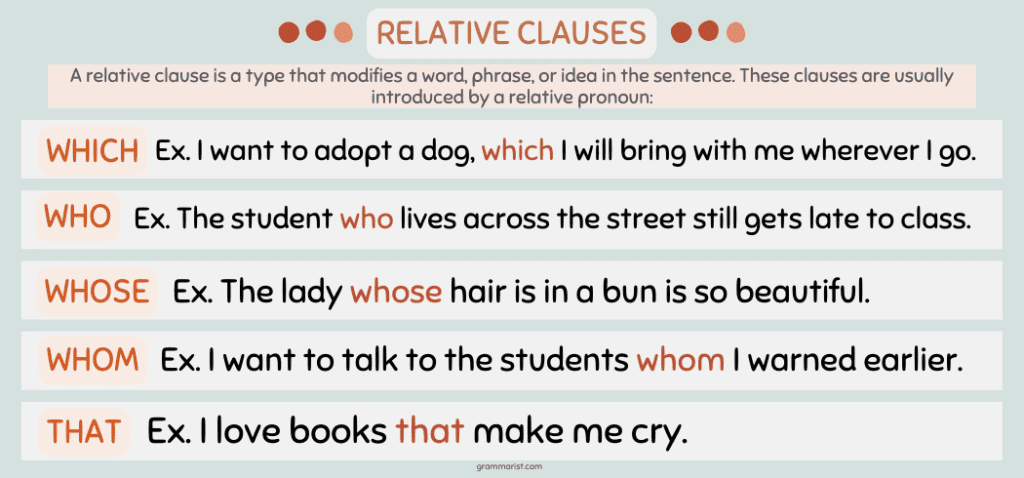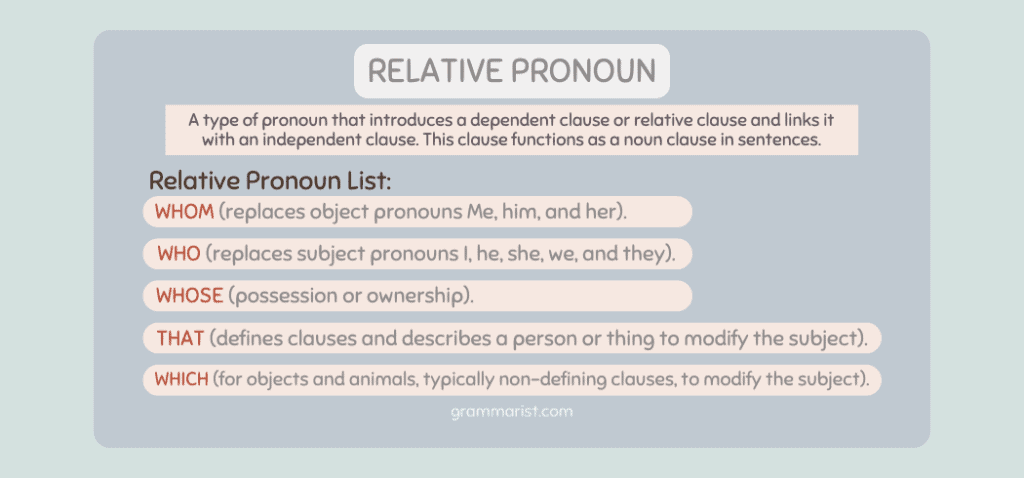You’ve probably heard of the term relative clause in the English language. But, if you haven’t, don’t worry! I’ll share everything you need to know.
This kind of clause is a dependent clause that starts with a relative pronoun. It’s essential to know its different types because it affects the choice of pronoun used for the clause.
I’ll talk about the relative clause definition and its kinds. I also included sentence examples in this guide and ample practice questions that will test your understanding of relative clauses.
What is a Relative Clause?

A relative clause is a type that modifies a word, phrase, or idea in the sentence. These clauses are usually introduced by a relative pronoun, such as which, who, whom, whose, and that.
Some examples of clauses of this type include which I got, whose book she lost, and that Rosie gave.
Like other clauses, a relative clause has a subject and a verb. However, it can’t stand alone as a sentence because it is a dependent clause. Also known as a subordinate clause, a dependent clause is a type of clause that does not express a complete thought.
Here’s an example of a relative clause.
- Online streaming is changing how we view cinema.
The sentence above shows the clause, how we view cinema, as the direct object. This clause answers the question, changing what?
What are the Two Types of Relative Clauses?
There are two types of relative clauses that modify nouns and noun phrases.
Restrictive Relative Clauses
A defining or restrictive relative clause is a clause that defines the meaning of a noun or noun phrase. As an essential clause, it provides crucial information about the noun in the sentence. Use that for non-human nouns and that or who for human nouns.
When someone says, “I like reading books,” you might ask, “Which books?” So, the speaker should add a clause like:
- That make me cry.
- That talk about love, history, and social issues.
- That are written by Candace Osmond (kidding…not really, though)
To complete the sentence containing a restrictive relative clause, we can say:
- I love books that make me cry.
- I like reading books that talk about love, history, and social issues.
Here’s an example using the relative pronoun who.
- Students who know the topics in class will get additional points.
Here, we use who because it modifies the subject students. But when the relative clause modifies people in the objective case, we use whom. For example:
- I want to talk to the students whom I warned earlier.
When showing ownership, we use the relative pronoun whose. For example:
- The lady whose hair is in a bun is so beautiful.
Unlike non-defining relative clauses, defining relative clauses are not separated from the rest of the sentence by commas.
Non-Restrictive Relative Clauses
A non-restrictive relative clause provides extra information about the noun or noun phrase that is non-essential.
Even if the information is interesting, it is not necessarily essential to identifying the noun. For example:
- My parents, who were born in Texas, are moving to another state this month.
We can use any relative pronoun for non-restrictive clauses except that. It’s also worth knowing that relative clause sentences have clauses separated from the noun by commas. Here are more examples.
- I want to adopt a dog, which I will bring with me wherever I go.
- I’m traveling for work next week, which is going to be exciting.
A non-restrictive clause is also known as a non-defining or non-essential clause. Some people also call them non-identifying relative clauses.
Rules for Using Relative Clauses
Relative clauses have distinct rules from other sentence clauses. Follow these guidelines to produce grammatically correct sentences.
Use the Correct Relative Pronoun or Adverb

Ensure your relative clause begins with a relative pronoun or adverb to emphasize the noun it refers to. Here’s a correct explanation.
- Who replaces subject pronouns that refer to individuals.
- Whom replaces an object pronoun for people
- Whose is for showing ownership.
- Which is a pronoun for animals and objects for non-restrictive clauses.
- That is for restrictive clauses that refer to people and things.
How to Use Commas
Do not set off defining clauses from the independent clause using commas. Consider this example:
- The student who lives across the street still gets late to class.
Who lives across the street is the restrictive relative clause in the sentence, modifying the student. It gives the necessary context to the sentence to help readers understand what they are talking about.
Only use commas for non-defining clauses or non-restrictive clauses. For example:
- My friend, whom you met last week, will attend my party.
Adverb Clause
A relative adverb clause is a verb modifier to provide extra information about a verb. For example:
- I study where I passed the entrance test because it’s my only choice.
The relative adverb clause is where I passed the entrance test. It modifies the verb study.
Here’s another example.
- When I use the car, I usually travel more than 60 kilometers per hour.
In this sentence, when I use the car modifies the verb travel.
Adjective Clause
One of the types of clauses is the adjective clause. This relative clause provides information to nouns and noun phrases. For example:
- The girl whose bag was stolen ran to the police station.
In this sentence, whose bag was stolen modifies the girl.
Using Relative Clauses in Prepositional Phrases
A relative clause may contain a relative pronoun as part of a prepositional phrase. Do not remove the preposition. Instead, place it after the relative pronoun.
Use whom or which after the preposition instead of that. For example:
- The company in which I worked is rebranding.
If you want to place the preposition at the end of the clause, you can use that. For example:
- The company that I worked for is rebranding.
Subject-Verb Agreement in Relative Clauses
You already know that a singular subject uses a singular verb, while a plural subject uses a plural verb. This rule applies to relative pronouns, as they substitute nouns. For example:
- This online class is difficult. This online class is about World Literature.
This online class, which is about World Literature, is difficult.
The subject in this sentence is online class, which is singular. Therefore, the singular be-verb is is used.
Here’s another example of a sentence with a relative clause showing subject-verb agreement.
- Povertyis an issue that needs to be solved in this country.
What is a Noun Clause?
While relative clauses are dependent clauses that modify a noun or a noun phrase in the sentence, noun clauses are dependent clauses that replace any noun in the sentence. Below is an example of a noun clause in a sentence.
- I told Jay to find out who stole the bag.
Who stole the bag is the noun clause in a sentence. It acts as an object of the infinitive phrase to find out.
What is a Contact Clause?
We can reduce some relative clauses by omitting the relative pronoun and other words. For example:
- I like books that talk about history.
I like books talking about history.
A contact clause is like a relative clause but without a relative pronoun. This clause is the object of the sentence and not the subject. For example:
- The TV show I am watching is ending soon.
Can Relative Pronouns Exist Without Other Nouns?
No. Some might think that relative pronouns can exist without the help of other nouns. However, this is an incorrect explanation. Relative pronouns must connect to another noun in a sentence to make sense.
Final Word on Relative Clauses
Now you know the definition of relative clauses thanks to my helpful guide. This type of dependent clause starts with a relative pronoun and modifies a noun or a noun phrase in the sentence. This type of clause has two kinds: restrictive and non-restrictive.
Remember that non-restrictive clauses are separated from the sentence with a comma, while restrictive clauses are. Do you want to learn more about clauses?